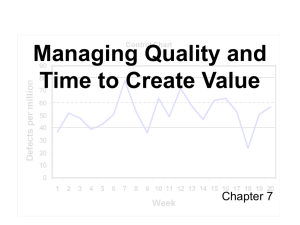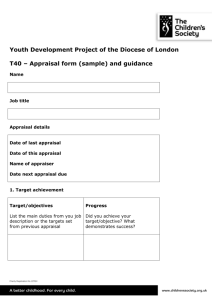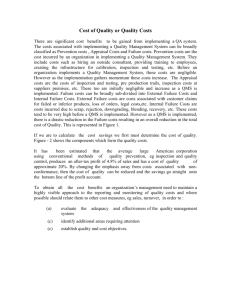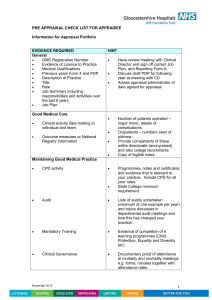The Nature of Costs
advertisement
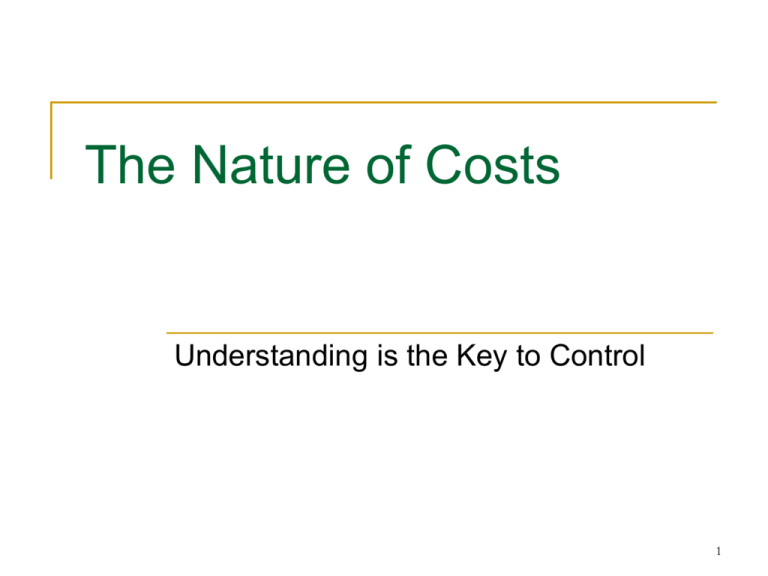
The Nature of Costs Understanding is the Key to Control 1 What is “Cost”? Assume you purchased a bottle of wine several years ago for $25. Today the same wine is selling for $100. You give your bottle of wine to your friend as a gift. What is the cost of your gift? $0 $25 $25+ $100 $(75) 2 Types of Costs Assets Potential future benefit Expenses Amounts consumed to produce revenue No future benefit Proper cost management involves the effective use of both types 3 Cost Drivers Cost driver is the thing that causes the cost to be incurred All costs are the result of some decision or activity Cost is a function of the amount of resource consumed and the price per unit of the resource Control efforts should focus on control of the underlying cost drivers and the unit costs Don’t try to do it cheaper, try to do less of it 4 Cost Drivers Capacity driver Cost is incurred to provide the capacity to perform some activity Transaction driver Cost is incurred each time the activity is performed Each output makes essentially the same demand on the resource 5 Cost Drivers Duration driver Amount of cost incurred depends on how long the activity is conducted Intensity driver Amount of cost incurred depends on numerous factors One activity may require the same amount of time as another, similar activity, but may consume different resources 6 Levels of Cost Incurrence Unit level Each additional unit of activity causes a corresponding increase in cost Examples: materials, commissions, etc. in which the cost benefits or relates to only one unit Traditional view of variable costs Frequently incorrect because many variable costs do not occur at the unit level 7 Levels of Cost Incurrence Batch level Each additional batch of activity causes a corresponding increase in cost Examples: setups, material handling, labor, packaging, shipping, etc. in which the cost benefits or is related to several units Often referred to as step costs 8 Levels of Cost Incurrence Product level Each additional product or change to a product causes a corresponding increase in cost Examples: design, engineering, tooling, etc. in which the cost benefits or is related to all units of the product or process Often misallocated to time periods Failure to consider the benefit of the cost to future periods 9 Levels of Cost Incurrence Facility level Change in the facility, capacity, etc. causes a corresponding change in the cost Examples: depreciation, administration, property taxes, insurance, etc. in which the cost benefits or is related to the entire facility or overall operations Often referred to as fixed costs Typically incorrectly allocated to products or processes on an arbitrary basis Reduces reliability and usefulness of information 10 Cost Behavior Fixed Constant in total Per unit decreases with increased activity Variable Constant per unit Total increases with activity 11 Cost Behavior Step variable Increases when some threshold of activity is crossed Mixed Contains both fixed and variable components 12 Committed vs. Discretionary Costs Committed Cost must be incurred by the organization or is largely unavoidable Often fixed in nature Discretionary Cost is incurred because management chooses to incur it 13 Controllable vs. Non-controllable Costs Controllable Non-controllable Can be controlled or incurred by management at a given level of the organization Beyond the control of management at a given level More costs are controllable higher up in the organization than at lower levels 14 Direct vs. Indirect Cost Direct Indirect Can be easily and conveniently associated with a particular cost object Cannot be easily and conveniently associated with a particular cost object A cost may be directly related to one cost object but indirectly related to another More costs can be directly related to higher levels than to lower levels 15 Disaggregation of an Organization Division A Revenue Variable costs Contribution margin Controllable fixed costs Controllable margin Non-controllable fixed costs Contribution by SBU Untraceable costs Operating income Company $ 2,000 1,100 $ 900 650 $ 250 100 $ 150 80 $ 70 Division A $ 1,400 900 $ 500 400 $ 100 75 $ 25 Division B $ 600 200 $ 400 250 $ 150 25 $ 125 Product 1 $ 900 500 $ 400 280 $ 120 40 $ 80 Not Product 2 traceable $ 500 400 $ 100 90 $ 30 $ 10 $ (30) 30 5 $ (20) $ (35) 16 Prevention, Appraisal and Failure Costs Prevention costs Costs incurred to prevent some detrimental outcome Training, product or system design, etc. Appraisal costs Costs incurred to detect the occurrence of a detrimental outcome Inspection, quality control, etc. 17 Prevention, Appraisal and Failure Costs Failure costs Internal failure costs Costs resulting from the detrimental outcome while the product is still within the company’s control Scrap, rework, etc. External failure costs Costs resulting from the detrimental outcome after the product leaves the company’s control Warranty repairs, recalls, lawsuits, lost sales, etc. 18 Prevention, Appraisal and Failure Costs Prevention and appraisal costs are inversely related to failure costs Spending on prevention can reduce appraisal and failure costs Spending on appraisal can reduce external failure costs Failures cannot be eliminated Goal is to minimize total costs 19 Prevention, Appraisal and Failure Costs Cost Prevention and appraisal costs Failure costs Total costs 1 3 5 7 9 11 13 15 17 19 21 Defects per 100,000 20 Prevention, Appraisal and Failure Costs Prevention, appraisal and failure costs are most often linked to quality control The concept can also relate to Environmental management Customer retention Employee retention Etc. 21 Organizational Models Ownership model Large investment in capital assets High fixed costs Costs do not fluctuate proportionately with changes in activity High risk, high return 22 Organizational Models Costs and revenues Revenue Total costs Variable costs Fixed costs Units 23 Organizational Models Rental model “Rent” capacity as needed (outsource) High variable costs Costs fluctuate with changes in activity Rent more when more is needed, rent less when less is needed Low risk, low return 24 Organizational Models Costs and revenues Revenue Total costs Variable costs Fixed costs Units 25 Ownership Model Variable costs = 25% of revenue Fixed costs = $50,000 Revenue Variable costs Contribution margin Fixed costs Net income $ $ $ 60,000 $ 15,000 45,000 $ 50,000 (5,000) $ 80,000 20,000 60,000 50,000 10,000 $ 100,000 25,000 $ 75,000 50,000 $ 25,000 $ 120,000 30,000 $ 90,000 50,000 $ 40,000 $ 140,000 35,000 $ 105,000 50,000 $ 55,000 $ 120,000 78,000 $ 42,000 10,000 $ 32,000 $ 140,000 91,000 $ 49,000 10,000 $ 39,000 Rental Model Variable costs = 65% of revenue Fixed costs = $10,000 Revenue Variable costs Contribution margin Fixed costs Net income $ $ $ 60,000 39,000 21,000 10,000 11,000 $ $ $ 80,000 52,000 28,000 10,000 18,000 $ 100,000 65,000 $ 35,000 10,000 $ 25,000 26 Management of Costs Proper cost management requires understanding what causes costs to be incurred a long-term perspective a holistic approach a focus on relevant costs understanding the impact of cost structure on costs and profits understanding that cost cutting is only one method of cost management 27 Management of Costs Understand the cost drivers Understand what activities you perform, why, and what they cost “Everything you do costs money, and doing nothing also costs money” Do not try to do unnecessary activities cheaper, try to do less of the activity 28 Management of Costs Long-term perspective Misguided short-term cost cutting can have longterm implications Wise spending on investments may save money in the long run Focusing on quarterly or annual results hinders investment in projects with long lead times 29 Management of Costs Holistic approach Must consider costs in relation to overall operations and other costs Cutting costs in one area may cause an even greater increase in costs in another area Spending more in one area may reduce costs in another area 30 Management of Costs Identification of relevant costs If a cost will not alter a decision, it is irrelevant and should be ignored Relevant costs differ between alternatives Present and future costs may be relevant Incremental or differential costs Previous (sunk) costs are always irrelevant Opportunity costs are always relevant 31 Management of Costs Impact of cost structure on profits If a large proportion of costs are fixed Little cost fluctuation with changes in activity If a large proportion of costs are variable Costs fluctuate with changes in activity High risk, high reward Low risk, low reward It is often possible to substitute one type of cost for another 32 Management of Costs Cost cutting is a subset of cost management Cost management involves resource management Proper cost management involves knowing when, where and how much to spend You can cut your way into a downward spiral You may spend your way out of a downward spiral 33
